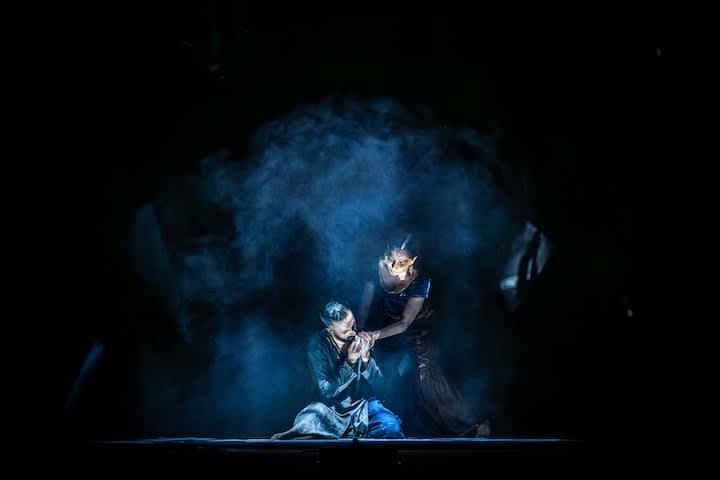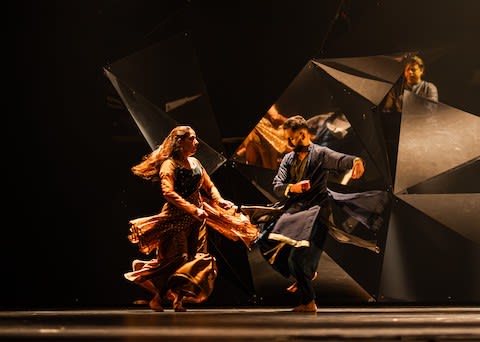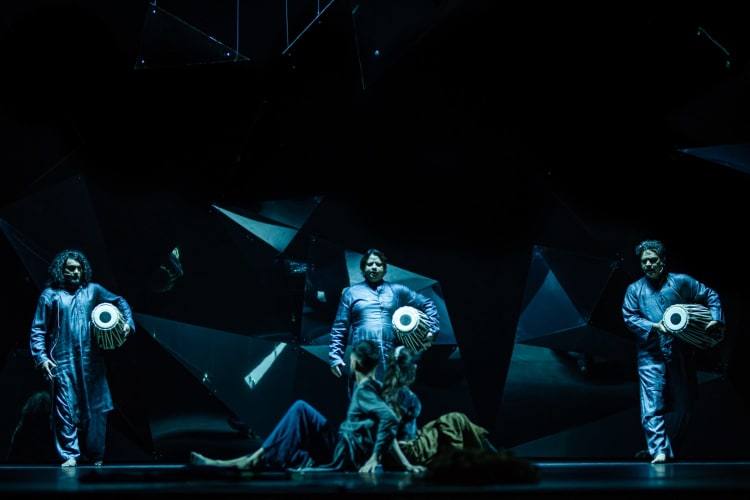Mehak is a thing of rare beauty. Movement, lighting, sets and music conspire to create a flowing outpouring of drama from visually arresting imagery to emotionally charged dance in an evening that etches deep into the sensory memory bank.
The title of the piece comes from the Hindi word for fragrance, alluding to sensations of memory and love. In this narrative, it's a tender portrait of love between a younger man and older women. Themes of heartbreak find convincing artistic expression in Aakash Odedra as the young suitor and Aditi Mangaldas, now in her sixties, in a beautifully timed, Kathak-inspired dance, proving the two a powerful duo.
Ushered into the auditorium, the audience are bathed in pitch black. The piece opens onto a face or a pair of hands lit with a sharp beam of white light, cancelling out all else, as if dismembered from the rest of the dancers' bodies. It takes a while to work out that there are, in fact, only two dancers onstage. There’s an otherworldliness infused in the onstage imagery as if we are witnessing a sacrilegious event or a scene from a parallel universe.
The movement is razor-sharp in execution, and both Odedra and Mangaldas are at the top of their game, spinning, chasing, clasping, flittering hands and fingers as if electricity is powering the two bodies and releasing out through their fingertips, bringing light into a gloomy cavernous space.
The combination of traditional Indian dance coupled with contemporary twists and swings of the arms and sweeping lunges is enthralling to watch. It also creates the perfect movement language to impart this impressionistic love story. Kathak dance gestures offer such a rich repertoire of precise hand inflections and dainty, yet powerful footwork. The dramatic embraces, then the rejections and Odedra’s spins. It’s as if there's a power battery hidden under his voluminous, elegant, gold-trimmed robes. He dips down, then swoops around, whirling faster than the mind can process, defying gravity as he picks up herculean speed. How is this humanly possible? The tight footwork, the leanness of form all comes into play.
Mangaldas is Odedra’s ideal dance partner. As he pounds with bravado, she winds around him elegantly and precise, equally feline and strong, another whirling vision in blue and gold, stamping feet and melting all at the same time. The gentle narrative is teased out through delicate mime sequences between the couple. There are achingly tender interactions. Mangaldas mimes washing her face and pouring water over her lover in series of intimate moments between the two before painfully being disrupted by the drummers.
In a change of pace, three brazenly strident on-stage drummers march mid-stage from the background. Ashish Gangani, Faraz Ahmed, Hiren Chate literally overshadow the lovers, and Gangani fights with Odedra, who retreats from the powerful pakhawaj playing and dissolves into the darkness and offstage.
Tina Tzoka’s inventive set is sheer art in itself. There are triangles suspended on invisible wires that catch the dancers and the musicians in a reflective glint, suggesting there’s something weightless, heavenly almost, in movement and visual messages. The triangles move with the action, sometimes still, sometimes swinging, but lending great depth and intrigue to the drama of movement and form. Then sharp beams of light highlight the lovers’ embrace and loss as if their love is catapulted into another dimension. It’s visually stimulating and beautiful, bathed in Fabiana Piccioli’s eery, accurate light shards that clip the end of movements and the beginnings of new ones.
Then there’s the powerful score by Nicki Wells. As she sings onstage, her face is reflected up high onto a mirrored triangular prism of light as if she’s singing somewhere from the heavens to grace the mere mortals below. It’s strange and unsettling as the perspective shifts and bends in a reflective and confusing sense of space, but brilliantly inventive.
I catch my breath in a little gasp as the finale plays out and white powder-like dust is poured from the rafters, enveloping the lovers, backlit by beams of light as they move in unison, a pair of star-crossed lovers becoming one wave about to break onto the shore.
A similar technique was seen in Samsara, replacing dust with sand as Odedra spun solo, but here the sentiment is different. There is a togetherness as the couple enfold and encircle, radiating out a sense of wellbeing and love. It's beautiful, elevating and infectiously lifts the spirits, emanating only hope through the power of movement and the lovers' reunion.


